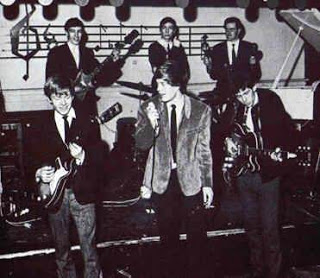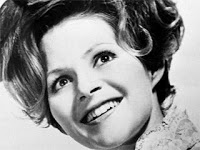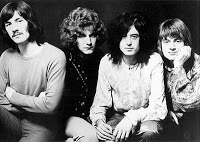Thanks for being patient during my relocation to San Diego. I’m finally all settled in and ready to make up to you for the wait.
We left off talking about how some of your favorite artists got their start way back in the 1950’s and 1960’s. We call these Future Superstars and today I’d like to bring you a whole bunch more examples. By the way, if you like these songs, you’ll hear over a thousand more just like them on MusicMaster Oldies!
Let’s start at the top! The music scene in the United States flew off the track in 1964 with the arrival of The Beatles. Here were four mop-top boys from Liverpool who turned teenage girls into screaming globs of jelly, literally making records fly off the store shelves, freaked out a whole bunch of record executives, caused several hit-making artists to hang up their microphone, and set the stage for a new generation of musicians with a new sound. It was English Freakbeat blended with American Rock and Roll and Rhythm and Blues. The names were quickly burned into the minds of teenagers all over the world. They were an instant success — or were they? Did John, George, Paul and Ringo step into the spotlight one day, or did they work their butts off trying to get their records heard and played and purchased. The truth is, they started out just like any other garage band in the wee early 1960’s, following a path that many other similar rock groups followed back in those days. The Beatles were not the only English band to start out in high school, play local gigs, take the act on the road, play live in clubs like the Cavern in Hamburg, Germany, and get signed by British record labels to do backing work for some big star. The Beatles first signed with Polydor in 1962 to make a record with headliner Tony Sheridan, calling themselves The Beat Boys. They were actually quite successful in the U.K. before anyone in America ever heard them play. Two more years had to pass before these guys got their big break on American radio. And the rest, as they say, was history.
Let’s give a listen to one of the Fab Four’s very first vinyl grooves. This is a cover of When The Saint’s Go Marching In which features Tony Sheridan on vocals. The drummer here is still Pete Best, the guy who got fired and replaced by Richard Starkey (Ringo Starr) just before the Beatles hit the big time. Talk about missing a golden opportunity! You can hear the distinctive beat style and guitar work of John Lennon and Paul McCartney on this track, back then being known as The Beat Boys. This record was produced by Bert Kaempfert shortly after he introduced himself to the band at the Top Ten club in Hamburg, Germany. Here now, from Polydor 24673, is Tony Sheridan And The Beat Boys doing The Saints (When The Saints Go Marching In):
Now check them out in an early BBC radio show. John Lennon loved the music of Chuck Berry, and here the boys do a cover of one of Chuck’s tunes called I Got To Find My Baby. John gets into a little argument with the announcer over the distinction between a Harmonica and a Mouth Harp, when in reality there’s no difference between them at all! Here are the Fab Four before most kids in the USA ever heard of them:
All the while Beatle-Mania was busting out in the USA, another British group of rockers was making the scene. These guys were first known as Little Boy Blue And The Blue Boys. Before cutting any records, they changed their name to The Rollin’ Stones, taken from a 1950 Muddy Waters recording that Mick Jagger owned called Rollin’ Stone. The legends vary, but the story I’ve heard most often is that band member Brian Jones was phoning in an ad for the new band in a local magazine called the Jazz News. The guy taking the order wanted to know the name of the band. Not having a name picked out yet, Brian Jones went into a bit of a panic — until he spied a track called Rollin’ Stone on a Muddy Waters album that just happened to be laying on the floor at the time. Long time Stones producer, Andrew Loog Oldham, adjusted the name to The Rolling Stones when they were first signed to Decca Records.
Their very first record is actually one of my favorite Chuck Berry tunes, Come On, issued in 1963 on Decca 11675. The group played the song live on a TV show called Thank Your Lucky Stars, but they never really liked the song. Their manager, Andrew Loog Oldham, actually encouraged Fan Club members to run out and buy multiple copies of the single trying to prop up the sagging sales. It managed to sneak up to #21 on the British charts. Here are The Rolling Stones doing Come On:
Their second record became a #1 hit in the U.K., but the real story is on the flip side of that original release. The first pressings had a song on the back called Stoned, which was dropped from later issues of the hit side, I Wanna Be Your Man, a song penned by John Lennon and Paul McCartney. I have a copy of London 9641 which would probably fetch as much as $7,500 if it didn’t have a very slight crack on one edge. The crack doesn’t keep it from playing, but when you pay that much for a record you don’t want it to be cracked! Here are The Rolling Stones doing Stoned, a song that was virtually impossible to find until CD box sets started appearing with reissues of every track the band ever recorded:
Now if the Beatles and the Stones aren’t big enough for you, let’s turn now to one of the world’s first Supergroups — Led Zeppelin. These guys certainly didn’t just start making records like Stairway To Heaven without first working really hard behind the scenes. It’s called “paying your dues” and these boys certainly did a lot of it.
Here is what may be Brenda Lee‘s most rocking record, probably because it features a young studio musician on guitar named Jimmy Page, before his appearance in The Yardbirds, and well before he hit the big time in Led Zeppelin, Give a listen to Is It True, one of Brenda Lee’s most collectable records on Decca 31690 from 1964:
Now listen to The Bitter Thoughts Of Little Jane by Timon, a band that featured both Jimmy Page and John Paul Jones of Led Zeppelin fame, plus an English singer-songwriter and multi-instrumentalist named Tymon Dogg (born Stephen John Murray) who later worked with The Clash. Here then is pop-psych flower power music at it’s best from 1968, The Bitter Thoughts Of Little Jane by Timon on Pye 7N 17451:
Now check this out! A band called Listen featured a very talented young singer named Robert Plant, future partner in crime with Jimmy Page in Led Zeppelin. Here are both sides of the record they made on Columbia 43967 in 1967. This is a pretty rare 45 single, but you can find copies of it around. I have two of them, after selling one to a fellow record dealer for about $500 a few years ago! Interestingly, you won’t find any mention of Robert Plant‘s involvement with Listen on Wikipedia!
Let’s start with Everybody’s Gonna Say by Listen, a song co-written by Robert Plant:
The flip side is a cover of a Young Rascals tune, also sung by Robert Plant. Here’s You Better Run by Listen:
To close this out, let’s hear a young John Bonham and Robert Plant together in a 1967 group they called Band Of Joy doing a cover of Buffalo Springfield’s For What It’s Worth. This was a demo recording that was never officially released on vinyl:
That’s it for today. I promise to continue this fun in future posts, hopefully at least once a week! In the meantime, please keep enjoying MusicMaster Oldies and tell all your friends about it!




